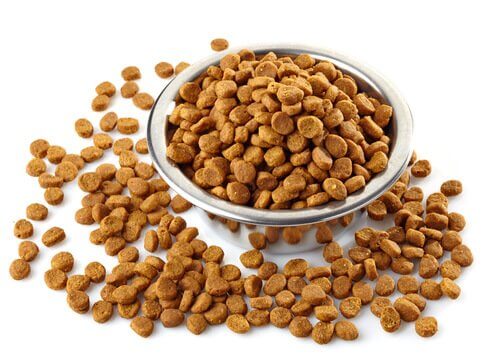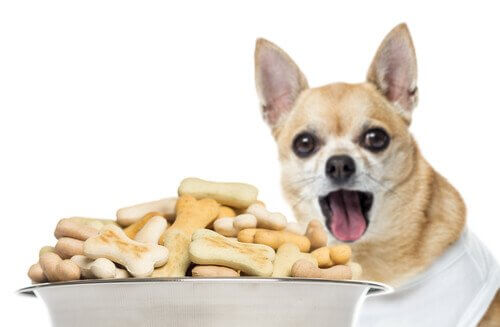Carbs in Dog and Cat Food: What Exactly Are They?


Written and verified by the lawyer Francisco María García
Carbs in dog and cat food are one of the your pet’s essential needs, as he needs them in order to be in excellent health. Regardless of their species, age, or gender, all animals require proper nutrition to develop physically and mentally.
To help you with the best nutrition for your pet, today we’ll talk about the added carbs in dog and cat food. We’ll also mention their possible health benefits and risks.
What are carbs?
Carbon, hydrogen, and oxygen make up carbohydrate biomolecules. As animal nutrients, they represent the main source of immediate energy.
During the digestive process, these biomolecules are metabolized to give rise to glucose molecules. That is, carbs are converted into sugars by the internal organs of any animal that consumes them.
When the body needs to produce energy quickly, it first turns to the glucose molecules derived from carbs. Glucose is easily metabolized and can generate a lot of energy in a short period of time.
However, this energy is also used quickly, and it needs to be consumed frequently in order to regulate the animal’s metabolism. In turn, proteins and good fats require a slower and gradual metabolization process, and that makes them better sources of long-term energy.
Types of carbs in dog and cat food

Carbs are one of the most common biomolecules in nature, as they’re present in almost all foods. Even though they tend to appear in greater proportion in foods of vegetable origin, others, such as dairy products and meat itself, are not exempt from carbs.
Currently, several types of carbs are recognized and are classified into two main groups: simple carbs and complex carbs.
Simple carbs
Simple carbs are those that have simple glucose molecules or sugar chains that are easy to break. The metabolization of its structure generates immediate energy. Carbohydrates subdivide into two:
- Monosaccharides: Here, the absorption of simple molecules of glucose happens directly, and they don’t require any conversion. Monosaccharides are galactose (a type of sugar present in milk and its derivatives), fructose and glucose (present in fruits, vegetables, and honey).
- Disaccharides: Sugar chains that are simple and easy to break, which require simple metabolization. Among the disaccharides are lactose (milk and derivatives), maltose (barley and honey), and sucrose (fruits and vegetables).
Complex carbs
Complex carbohydrates, also called polysaccharides, contain sugar chains which are longer and more difficult to metabolize; therefore, they require a slower digestive process for proper absorption. In this group, we find starches (cereals, tubers, and legumes), glycogen (meats), and fibers (fruits, vegetables, cereals, and legumes).

Are carbs in dog and cat food bad?
The matter of carbohydrates in pet food generates much controversy, even among experts in animal nutrition. Unlike humans, these animals have a short gastrointestinal tract and they can’t digest long sugar chains.
Keep in mind that dogs and cats get energy for their metabolism mainly from fat molecules, and not from carbohydrates. In fact, their natural diet is based on the consumption of meat and fat and hardly includes grains and seeds (cereals, legumes and other sources of vegetable protein).
Therefore, you shouldn’t incorporate polysaccharides into your dog or cat’s diet. The only exception here is glycogen, which is present in low amounts in meat. However, the moderate consumption of simple carbs (present in most fruits and vegetables) that also provide vitamins and minerals, can help supplement the nutrition of your animal friends.
Furthermore, carbohydrates don’t provide all of the nutrients that dogs and cats’ bodies need to remain healthy and balanced. For this reason, carbs shouldn’t be the basis of their diet. This is because nutritional deficiencies would arise due to an insufficient consumption of proteins, vitamins, and minerals.
If we specifically analyze food for dogs and cats, their content of carbs shouldn’t exceed 5% in the case of cats, and 10% in the case of dogs.
Excessive consumption of carbs usually leads to digestive problems such as flatulence, diarrhea, and vomiting. In addition, it can lead to rapid weight gain and to the rise of blood sugar, which would predispose the animal to obesity and diabetes.
All cited sources were thoroughly reviewed by our team to ensure their quality, reliability, currency, and validity. The bibliography of this article was considered reliable and of academic or scientific accuracy.
- Ernesto Rodolfo Hutter. 2015. Nutrición en caninos y felinos. Extraído de: http://www.vet.unicen.edu.ar/ActividadesCurriculares/AlimentosAlimentacion/images/Ducumentos/2015/Nutricion%20en%20caninos%20y%20felinos%20-%20Dr%20Hutter.pdf
- Jof the American Animal Hospital Association. OURNA. 2010. Guías para la Evaluación Nutricional de perros y gatos. Extraído de: https://www.aaha.org/public_documents/professional/guidelines/nag_spanish_color.pdf
This text is provided for informational purposes only and does not replace consultation with a professional. If in doubt, consult your specialist.